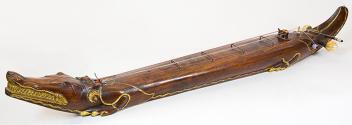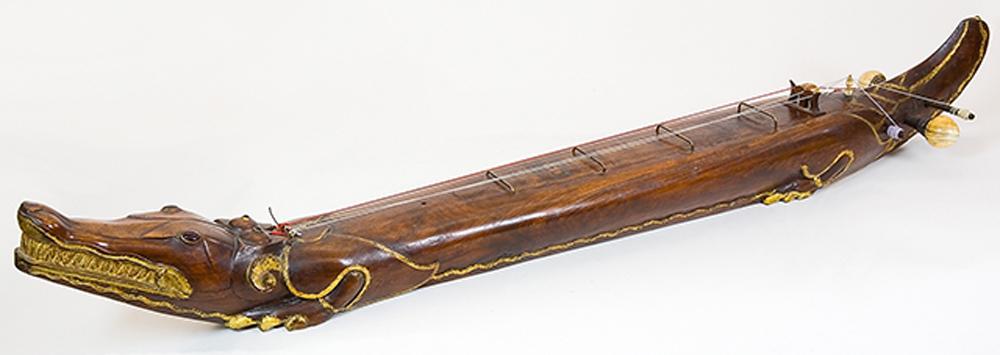Advanced Search
Folk, Indigenous, and Global
Zithers and Dulcimers
Mi-gyaung
Alternate name:Kyam
Alternate name:Crocodile zither
Alternate name:Mi-gyaun
Alternate name:Megyaun
Maker: attributed to Mon people
Date: 1860-1885 ca.
Place Made:Myanmar (Burma), Asia, southern region
Serial No: none
Signednone
Markingsnone
DescriptionElegantly carved teak wood body with gold leaf embellishments throughout. Three wooden pegs with ivory tips resembling lotus flower buds.
Sometimes referred to as a crocodile zither, this instrument is known for its characteristic buzzing sound, said to emulate a crocodile's mating call. Often, when an instrument mimics an animal, it is believed one can access qualities inherent to the animal, in this case, strength and ability to easily move from land to water. This may be associated with passage between the lands of the living and the dead.
The instrument likely originated with the Mon people, an ethnic group that inhabited the Irrawaddy River delta, believed to be among the earliest civilizations in the area. Later, as power and territory shifted, the Mon were divided between Myanmar (Burma) and Thailand. It may be for this reason that similar zithers can be found in Thailand and neighboring Cambodia.
Sometimes referred to as a crocodile zither, this instrument is known for its characteristic buzzing sound, said to emulate a crocodile's mating call. Often, when an instrument mimics an animal, it is believed one can access qualities inherent to the animal, in this case, strength and ability to easily move from land to water. This may be associated with passage between the lands of the living and the dead.
The instrument likely originated with the Mon people, an ethnic group that inhabited the Irrawaddy River delta, believed to be among the earliest civilizations in the area. Later, as power and territory shifted, the Mon were divided between Myanmar (Burma) and Thailand. It may be for this reason that similar zithers can be found in Thailand and neighboring Cambodia.
DimensionsLength: 790 mm (31 in)
ProvenancePurchased in 1979, from Wurlitzer-Bruck, New York, New York, who purchased it at Sotheby's, London, England, lot 52, 19 June 1979.
Terms
Credit Line: Board of Trustees, 1979
Not on view
Published ReferencesThomas E. Cross, Instruments of Burma, India, Nepal, Thailand, and Tibet, Shrine to Music Catalog Vol. II (1982), p. 3.
Thomas E. Cross, Instruments of Burma, India, Nepal, Thailand, and Tibet in the
Collections of the Shrine to Music Museum, MM Thesis, University of South Dakota,
1983, p. 54, plate XXII.
Thomas E. Cross, Instruments of Burma, India, Nepal, Thailand, and Tibet in the
Collections of the Shrine to Music Museum, MM Thesis, University of South Dakota,
1983, p. 54, plate XXII.
Object number: 02618









